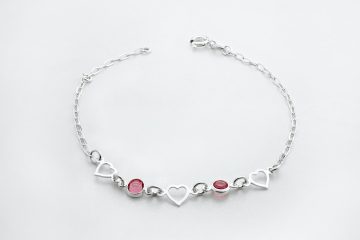Are you looking to unlock your creativity and dive into the world of jewelry making? Bracelet making is a fantastic way to express your personal style and create something unique. Whether you’re a beginner or have some experience, there’s a wide range of easy bracelet patterns that will inspire your creative journey. In this article, we’ll explore some simple and captivating bracelet patterns that are perfect for beginners, allowing you to unleash your creativity and make stunning pieces of jewelry.
Introduction to Bracelet Making
Bracelet making is a fun and rewarding craft that allows you to showcase your personal style through wearable art. With a wide range of materials to choose from, such as beads, threads, cords, and chains, the possibilities are endless. Before we dive into the easy bracelet patterns, let’s cover some basic techniques and materials you’ll need to get started.
Materials
: To begin your bracelet making journey, you’ll need some essential materials. These include beads (glass, acrylic, or gemstone), threads or cords (nylon, silk, or cotton), clasps, jump rings, and pliers. Additionally, you may want to have a bead mat or tray to keep your beads organized.
Basic Techniques
: Bracelet making involves several basic techniques that are easy to learn. These techniques include stringing beads, knotting, braiding, and attaching clasps. Don’t worry if you’re new to these techniques; we’ll guide you through each pattern step by step.
1. Simple Beaded Bracelet
The simple beaded bracelet is a classic and versatile design that is perfect for beginners. This pattern allows you to experiment with different bead shapes, sizes, and colors, making it an ideal starting point for unlocking your creativity.
Materials
: For this bracelet, you’ll need beads of your choice, beading thread or cord, a beading needle, a clasp, and jump rings.
Instructions
:
1. Measure your wrist and cut a piece of beading thread or cord that is slightly longer than your wrist measurement.
2. Attach a clasp to one end of the thread using a jump ring.
3. String your chosen beads onto the thread, creating a pattern or random arrangement.
4. Once you’ve added enough beads, attach the other end of the clasp using a jump ring.
5. Tie a secure knot to secure the clasp and trim any excess thread.
2. Macrame Bracelet
Macrame is a popular technique that involves knotting threads or cords to create intricate patterns. This technique is perfect for beginners as it only requires a few basic knots but offers endless design possibilities.
Materials
: To create a macrame bracelet, you’ll need waxed cords or nylon threads in different colors, a clasp, jump rings, and a macrame board or clipboard.
Instructions
:
1. Cut four equal lengths of cord or thread, approximately double the desired length of your bracelet.
2. Fold the cords in half and attach them to a clasp using jump rings.
3. Secure the folded end of the cords to a macrame board or clipboard.
4. Start by creating a square knot with the outer cords by crossing them over the middle cords. Repeat this step several times until you achieve your desired bracelet length.
5. To add a decorative element, you can incorporate beads into your macrame pattern by sliding them onto the middle cords before tying the square knots.
6. Once you’ve reached the desired length, tie a secure knot and attach the other end of the clasp using jump rings.
3. Charm Bracelet
A charm bracelet is a delightful way to showcase your personality and memories. This bracelet style allows you to add charms of your choice, such as letters, symbols, or tiny trinkets, creating a unique piece that tells your story.
Materials
: To create a charm bracelet, you’ll need a chain bracelet, jump rings, charms, pliers, and a clasp.
Instructions
:
1. Start by opening a jump ring using pliers and attach it to the end of the chain bracelet.
2. Slide your chosen charms onto jump rings and attach them to the chain bracelet at regular intervals.
3. Once you’ve added all the desired charms, attach the other end of the clasp using a jump ring.
4. Friendship Bracelet
Friendship bracelets are not only a symbol of friendship but also a popular craft among beginners. These bracelets are made using various knotting techniques and can be customized with different colors, patterns, and even names.
Materials
: To create a friendship bracelet, you’ll need embroidery threads or cords in different colors, scissors, and tape.
Instructions
:
1. Choose the colors of threads you want to use for your friendship bracelet.
2. Cut multiple strands of thread, each approximately double the desired bracelet length.
3. Align the threads and tie a knot at one end, leaving a small loop.
4. Secure the loop to a flat surface with tape, making it easier to work with the threads.
5. Start by dividing the threads into groups and knotting them together using various techniques like the forward knot or backward knot.
6. Continue knotting until you’ve reached the desired bracelet length, periodically changing thread colors or patterns.
7. Once complete, tie a knot at the end, leaving a small loop for the clasp.
8. Attach a jump ring and clasp to the loops at each end of the bracelet.
5. Leather Wrap Bracelet
Leather wrap bracelets are stylish and versatile accessories that can add a touch of bohemian charm to any outfit. This pattern combines leather cords with beads or charms, making it an ideal choice for beginners looking to create a trendy and personalized bracelet.
Materials
: To create a leather wrap bracelet, you’ll need leather cords, beads or charms, a button or toggle clasp, a beading needle, and beading thread.
Instructions
:
1. Measure your wrist and cut a length of leather cord that is approximately double the wrist measurement.
2. Attach one end of the cord to a button or toggle clasp using beading thread and a needle.
3. String your chosen beads or charms onto the cord, leaving enough space between each bead for wrapping.
4. Once you’ve added enough beads, tie a knot at the end of the cord to secure them in place.
5. Wrap the cord around your wrist and mark where the button should be placed for a comfortable fit.
6. Attach the button or toggle clasp to the marked spot using beading thread and a needle.
Conclusion
Unlocking your creativity through bracelet making is a wonderful journey that allows you to express your personal style and create unique pieces of jewelry. Whether you choose to make simple beaded bracelets, try macrame techniques, create charm bracelets, craft friendship bracelets, or experiment with leather wrap designs, there are endless possibilities to explore. Remember to have fun, embrace your creativity, and let your imagination guide you as you embark on this exciting craft. Happy bracelet making!
FAQs
Q1. Can I use different materials for these bracelet patterns?
Absolutely! The beauty of bracelet making is that you can experiment with various materials. Feel free to explore different types of beads, cords, threads, and charms to make the patterns truly your own.
Q2. I’m a complete beginner. Which pattern should I start with?
If you’re new to bracelet making, the simple beaded bracelet pattern is an excellent choice. It allows you to familiarize yourself with the basic techniques and materials while still creating a beautiful piece of jewelry.
Q3. Where can I find the materials needed for bracelet making?
You can find bracelet making materials at your local craft stores, online marketplaces, or specialized jewelry supply shops. Explore different options to find the best quality and variety for your projects.
Q4. Can I modify the patterns to suit my preferences?
Absolutely! These patterns serve as a starting point, but feel free to modify them to suit your preferences. Experiment with different colors, sizes, and patterns to create unique bracelets that reflect your personal style.
Q5. Are these bracelet patterns suitable for kids?
Most of these patterns are beginner-friendly and can be enjoyed by kids, provided they have adult supervision. Bracelet making is a great activity for children to explore their creativity and develop fine motor skills.




